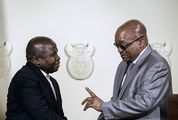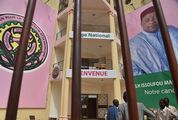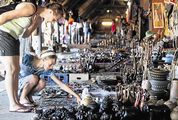HALF ART: Failure to stay open dogs debate
by Chris Thurman,
2016-02-19 05:51:52.0
SO STEPHEN Fry has left Twitter, despairing that it is "a stalking ground for the sanctimoniously self-righteous". This, just days after the Harvard Business Review declared that Twitter has become "less like a digital town square and more like a mosh pit … plagued by harassment, abuse, bullying, intimidation and threats".
I understand why Fry felt he’d had enough. Twitter can occasionally function as an "outrage machine" fuelled by some users’ sense of moral or intellectual superiority (although it regularly betrays the opposite). It is a means of venting frustration not dissimilar to road rage. Still, I’m not ready to give up on Twitter just yet.
There are valid reasons to critique a "call-out culture" in which perceived wrongdoers are named by influential individuals and then shamed by a largely anonymous collective. But it can serve a greater social good, when for example bigotry is exposed or public consciousness is attuned to the discourses of everyday racism and sexism. I, for one, am glad that sports journalist Dan Retief has been hauled over the coals for his idiotic tweet about "white Afrikaners" carrying the national cricket team to victory over England.
If Twitter has its limitations in constructive engagement, this is only partly the nature of the medium. The problem is that human beings generally aren’t good at dialogue, discussion and debate.
The inability of South Africans to find each other through the exchange of words — virtually or in person — has been everywhere on display of late. It is especially worrying that this seems to be the case at institutions supposedly built around the ideal of reasoned, if heated, argument.
In Parliament, the state of the nation address and the verbal sparring that followed it did not give citizens much cause for enthusiasm. At the University of Cape Town, a standoff between management and #RhodesMustFall activists ended in tear gas, rubber bullets and the smoke from fires in which "colonial" artworks had been destroyed.
Here the protesting students did themselves a disservice in their recourse to slash-and-burn tactics. By all means, tackle the university over the legacy of Jan Smuts; but destroying portraits and defacing busts simply because their subjects have white skin, regardless of each individual’s actions and political views, is lazy revisionist historiography.
Last week I wrote about "FUCK WHITE PEOPLE", a catchphrase of sorts among would-be revolutionary graffiti artists on T-shirts and walls at some university campuses. One of the more considered responses I received was an expression of sadness that — however understandable the anger behind the message may be — "it’s difficult to dialogue with ‘FUCK YOU’."
Prejudice is inevitable; it is a consequence of subjectivity. As philosopher Hans-Georg Gadamer noted, a person’s identity is basically the sum of his or her prejudices. For Gadamer the question is how we share our different subject positions: "There is no higher principle," he wrote, "than holding oneself open in a conversation … even in the wreckage of agreement, in misunderstanding, and in the admission of ignorance."
South Africans could do worse, then, than to follow the example in the twin exhibitions at Lizamore & Associates: African Equations and Ik ben een Afrikander: The unequal conversation.
The latter exhibition is the fourth instalment in a series that takes as its starting point the earliest known declaration of Afrikaner identity (by one Hendrik Biebouw in 1707), allowing artists to reflect on what it means to be Afrikaans in SA today. The acknowledgement that this has previously been an "unequal conversation" dominated by white male artists introduces a necessary self-consciousness about the power dynamics in the visual arts sector.
Ik ben een Afrikander is, in turn, in conversation with African Equations, which challengers visitors to reconsider the descriptor "African" — here used as synonymous with "black". Setlamorago Mashilo combines conflicting metonyms: the mielie field, the revolutionary soldier and the ever-ubiquitous Hillbrow tower. Lwandiso Njara’s astonishing sculptural work seems to suggest that his "African" and "western" identities are irreconcilable. But they remain, at least, in dialogue with one another.
• African Equations and Ik ben een Afrikander: The unequal conversation. Lizamore & Associates, 142 Jan Smuts Ave, Parkwood, Johannesburg, to February 27
-

Picture: LIZAMORE & ASSOCIATES
-

Setlamorago Mashilo, The Land's Lord V (2016), detail. Monoprint. Picture: LIZAMORE & ASSOCIATES
SO STEPHEN Fry has left Twitter, despairing that it is "a stalking ground for the sanctimoniously self-righteous". This, just days after the Harvard Business Review declared that Twitter has become "less like a digital town square and more like a mosh pit … plagued by harassment, abuse, bullying, intimidation and threats".
I understand why Fry felt he’d had enough. Twitter can occasionally function as an "outrage machine" fuelled by some users’ sense of moral or intellectual superiority (although it regularly betrays the opposite). It is a means of venting frustration not dissimilar to road rage. Still, I’m not ready to give up on Twitter just yet.
There are valid reasons to critique a "call-out culture" in which perceived wrongdoers are named by influential individuals and then shamed by a largely anonymous collective. But it can serve a greater social good, when for example bigotry is exposed or public consciousness is attuned to the discourses of everyday racism and sexism. I, for one, am glad that sports journalist Dan Retief has been hauled over the coals for his idiotic tweet about "white Afrikaners" carrying the national cricket team to victory over England.
If Twitter has its limitations in constructive engagement, this is only partly the nature of the medium. The problem is that human beings generally aren’t good at dialogue, discussion and debate.
The inability of South Africans to find each other through the exchange of words — virtually or in person — has been everywhere on display of late. It is especially worrying that this seems to be the case at institutions supposedly built around the ideal of reasoned, if heated, argument.
In Parliament, the state of the nation address and the verbal sparring that followed it did not give citizens much cause for enthusiasm. At the University of Cape Town, a standoff between management and #RhodesMustFall activists ended in tear gas, rubber bullets and the smoke from fires in which "colonial" artworks had been destroyed.
Here the protesting students did themselves a disservice in their recourse to slash-and-burn tactics. By all means, tackle the university over the legacy of Jan Smuts; but destroying portraits and defacing busts simply because their subjects have white skin, regardless of each individual’s actions and political views, is lazy revisionist historiography.
Last week I wrote about "FUCK WHITE PEOPLE", a catchphrase of sorts among would-be revolutionary graffiti artists on T-shirts and walls at some university campuses. One of the more considered responses I received was an expression of sadness that — however understandable the anger behind the message may be — "it’s difficult to dialogue with ‘FUCK YOU’."
Prejudice is inevitable; it is a consequence of subjectivity. As philosopher Hans-Georg Gadamer noted, a person’s identity is basically the sum of his or her prejudices. For Gadamer the question is how we share our different subject positions: "There is no higher principle," he wrote, "than holding oneself open in a conversation … even in the wreckage of agreement, in misunderstanding, and in the admission of ignorance."
South Africans could do worse, then, than to follow the example in the twin exhibitions at Lizamore & Associates: African Equations and Ik ben een Afrikander: The unequal conversation.
The latter exhibition is the fourth instalment in a series that takes as its starting point the earliest known declaration of Afrikaner identity (by one Hendrik Biebouw in 1707), allowing artists to reflect on what it means to be Afrikaans in SA today. The acknowledgement that this has previously been an "unequal conversation" dominated by white male artists introduces a necessary self-consciousness about the power dynamics in the visual arts sector.
Ik ben een Afrikander is, in turn, in conversation with African Equations, which challengers visitors to reconsider the descriptor "African" — here used as synonymous with "black". Setlamorago Mashilo combines conflicting metonyms: the mielie field, the revolutionary soldier and the ever-ubiquitous Hillbrow tower. Lwandiso Njara’s astonishing sculptural work seems to suggest that his "African" and "western" identities are irreconcilable. But they remain, at least, in dialogue with one another.
• African Equations and Ik ben een Afrikander: The unequal conversation. Lizamore & Associates, 142 Jan Smuts Ave, Parkwood, Johannesburg, to February 27























Change: 0.35%
Change: 0.51%
Change: 0.17%
Change: -0.09%
Change: 2.43%
Data supplied by Profile Data
Change: 1.47%
Change: 1.31%
Change: 0.35%
Change: 0.00%
Change: 1.34%
Data supplied by Profile Data
Change: -1.35%
Change: -2.86%
Change: -2.31%
Change: -1.54%
Change: -0.22%
Data supplied by Profile Data
Change: -1.48%
Change: -1.39%
Change: -1.17%
Change: -0.60%
Change: 4.91%
Data supplied by Profile Data